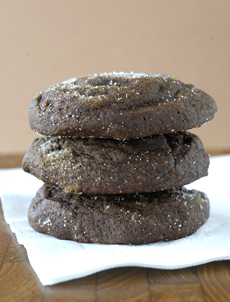

Molasses cookies—homey and historic, from the days when sugar was unaffordable to most households—from This Little Cookie. Photo by Dhanraj Emanuel.
November 2007
Updated January 2021
|
 |
The History Of Cookies
Page 3: Styles Of Cookies ~ A Cookie Glossary
This is Page 3 of a three-page article. Click on the black links below to visit other pages.
Styles Of Cookies
The 10 basic Styles Of Cookies are classified by the way the dough is handled. There’s also a “faux” cookie, the no-bake cookie.
- Bar Cookies. Here, batter or other ingredients are poured or pressed into a rectangular pan (sometimes in multiple layers), then baked and cut into individual-sized squares that have a dense cake-like consistency. Brownies and lemon bars are examples of bar cookies. In the U.K., bar cookies are known as “tray bakes.”
- Drop Cookies. A relatively soft dough is dropped by the spoonful onto the baking sheet. During baking, the mounds of dough spread and flatten. Chocolate chip cookies, oatmeal cookies and coconut macaroons are examples of drop cookies.
- Filled Cookies. Cookie dough is stuffed with fruit, jam or other confection. They can be like thumbprint cookies; or the fruit/jam can be totally enclosed in the dough, like a dumpling.
- Fried Cookies. These are fried dough, often dusted with powdered sugar. Examples include the Jewish/Polish krusczyki and the Italian zeppole. Fried dough is becoming increasingly popular, with chocolate chip cookie dough, oatmeal cookie dough and others all headed to the fryer.
- Molded Cookies. Made from stiff dough, these cookies are shaped by hand, with a mold or with a stamp, including a Springerle rolling pin, before baking. Wreath cookies are an example.
- No-Bake Cookies. A “faux” cookie, a kind of candy-cookie hybrid. An example is Rice Krispies Treats.
- Pressed Cookies. Made from a soft dough that is extruded from a cookie press (cookie gun) or pastry bag into various decorative shapes. Spritz cookies and French macarons are examples.
- Refrigerator Cookies or Ice Box Cookies. Made from a stiff dough that is refrigerated in logs until it becomes hard. It is then sliced into rounds and baked. Examples include pinwheels and shortbread.
- Rolled Cookies (Cutout Cookies). Made from a stiffer dough that is chilled and then rolled out and cut into shapes with a cookie cutter, knife or pastry wheel. Gingerbread men are an example (or any cookie made with a cookie cutter).
|
 Macaroons from Mad Mac, a NIBBLE Top Pick
Of The Week. Macaroons from Mad Mac, a NIBBLE Top Pick
Of The Week.
|
- Sandwich Cookies. Rolled or pressed cookies that are assembled as a sandwich with a sweet filling: frosting, ganache, jam, marshmallow creme and peanut butter creme are popular. The whoopie pie, made of two soft cookies with a vanilla creme filling, is an example (as is the iconic Oreo creme sandwich). French macaroons (photo above), two macaroons filled with a layer of ganache, are perhaps the most elegant example.
Go To Page 1: Overview & History Of Cookies
Go To The Article Index Above

|
| |





